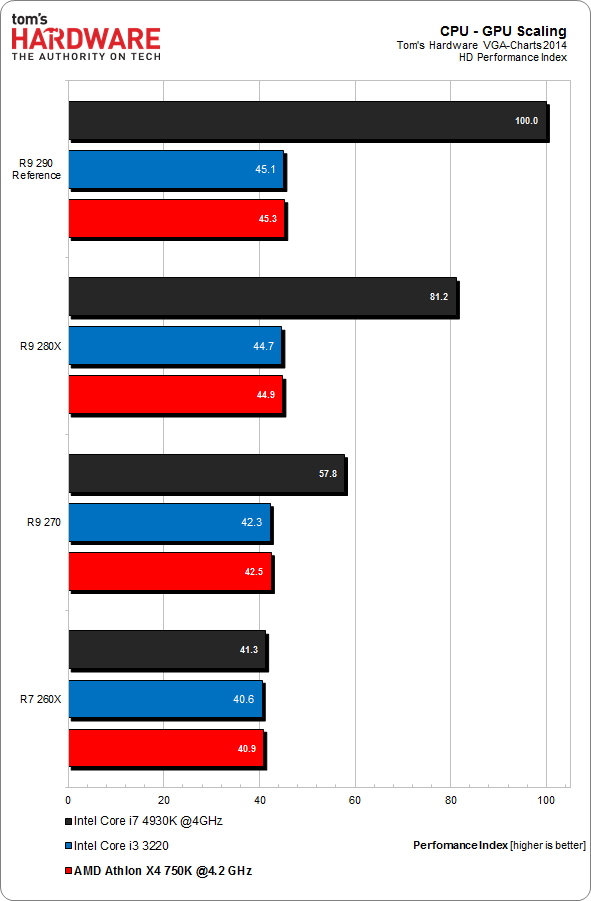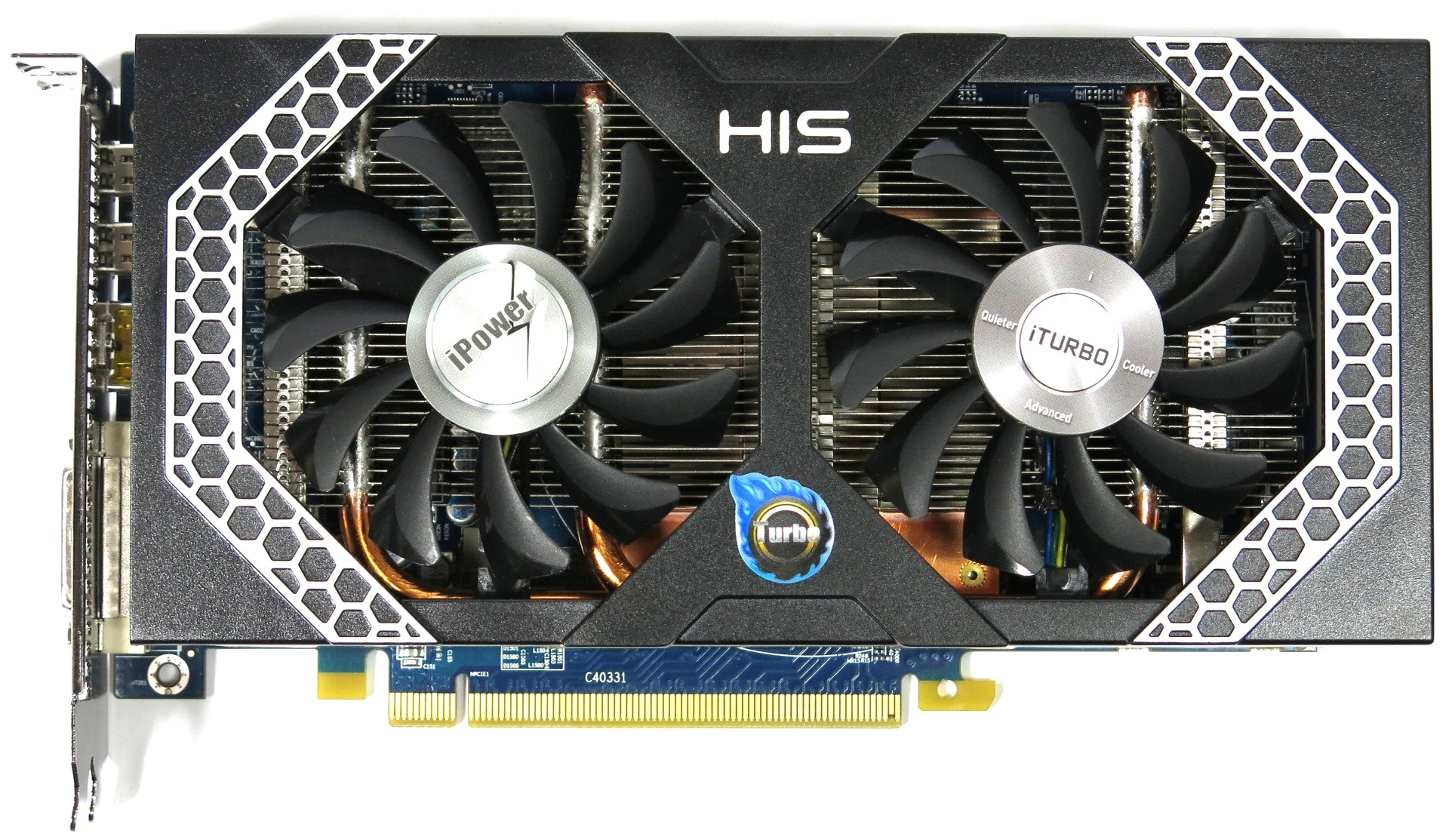Build A Balanced AMD-Based Gaming PC On A Budget
We’re revisiting an age-old question with a modern twist: can you build a balanced gaming PC with a sub-$100 CPU and not be limited by graphics performance? When you pick the right parts, a capable machine is easily within reach for very little money.
The Quest For The Right Graphics Card
Finding the Right CPU
We narrowed down our GPU choices slowly and carefully. In our newest Graphics Card Charts for 2014, we set AMD's reference-class Radeon R9 290 as the 100-percent mark for 1080p, identifying that as a good entry point into the gaming space.
From there, we used the same benchmarks with less and less powerful graphics cards until the processor stopped affecting the results. The card that emerged as our winner was somewhat surprising, since it enables plenty of 3D performance.
First, let's take a look at the process:

How Far Can We Take Our System?
The benchmark results demonstrate that a Radeon R7 260X performs almost identically on an Athlon X4 750K, Core i3-3220, or even an overclocked Core i7-4930K.
This means two things. First, if a Radeon R7 260X is all you can afford, there's no point to spending more than $80 on your CPU. A faster processor won't make a difference (at least in terms of gaming). Also, if you want to stick with an $80 CPU, you can see exactly how far a platform like that takes you, and at what point buying more graphics muscle stops paying off.
Naturally, the R7 260X makes the most sense if we're going for a well-balanced configuration. A Radeon R9 270 is another option if you plan to switch on anti-aliasing and other more taxing graphics details. Beyond that point, you're probably sinking more money into graphics than you need to.
If you read our Best Graphics Cards For The Money column, then you know that the Radeon R7 260X currently has Don's recommendation at the $120 price point. Nvidia's GeForce GTX 750 Ti is another option, and frankly, it's a lower-power and more elegant solution. But the cheapest 750 Tis are currently selling for $150. Given the budget levels we're working with, that $30 difference is a lot, even if the GM107-powered card is also quicker than its AMD-branded competition.
Get Tom's Hardware's best news and in-depth reviews, straight to your inbox.

Let’s get started on our pricing table, which we'll add to as the story progresses.
| Components | Baseline Build | Price | Stepping Up (Red Devil) | Price |
|---|---|---|---|---|
| Graphics Card | AMD Radeon R7 260X | $120 | AMD Radeon R9 270Nvidia GeForce GTX 750 Ti | $150 |
| Total | Row 1 - Cell 1 | $120 | Row 1 - Cell 3 | $150 |
Current page: The Quest For The Right Graphics Card
Prev Page Building An Entry-Level Gaming PC Next Page Picking A CPU, Motherboard, And RAM-
esco_sid It does not make sense to spend $80 on a case for a budget entry system why all the focus on eye candy at additional cost ? for the money you can get better hardware such as fx-6300 setup with better graphics card that's what i would be worried about while on a budget.Reply -
Memnarchon The minimum version is a trully great budget build, while the Red Devil is more ITX luxury build. An SSD and $80 case on a gaming budget? ;pReply -
Zeh Nice article, but I guess it's really important for readers to understand that the extra stuff is completely optional and the main point is #415 gets you a very decent (if not Good) gaming PC.Reply
We have $315 spent on eye candy, SSD and a little bit more thermal headroom, which is 76% of the 'cheap' budget.
Personally, I would only get the SSD. Maybe the MB with Wifi if I'm building something really small and would like to avoid cable clutter. Definately not gonna spend $50 on a bit more mhz, neither $55 on a case for cheap hardware, -
ddpruitt Now the trick is to benchmark both systems. Let's see if the "Bare Bones" build can keep up with the eye candy Red Devil build. I doubt there's a huge difference in performance, or perceptible noise levels. For a system that costs almost twice as much you might be able to be handle cost by going for functionality instead of looks. 240Gb SSD (or potentially more), better CPU or better GPU, though to each his own.Reply
For bonus points it would be nice to compare the budget build to a console in the same price range, but alas an Apples to Apples comparison isn't possible. -
Onus I really want to like articles like this. I lurk at the "budget" end of the spectrum myself, and some of the analysis on this one is really good, but I absolutely agree with Zeh; so much optional stuff was covered that it really distracted from what I expected to be the main point.Reply
I would have liked to have seen the bottom dollar build done first, followed by a discussion of what upgrades or enhancements might be substituted.
Also, at least a few benchmarks are needed, if only to show that yes, this is a competent gamer, especially if "good" but less-than "UltraMaxOhWOW" settings are used. -
vertexx Nice article. This is definitely the way to present gaming system design, especially with graphics card selection based on CPU scaling. I really think the "Best Gaming CPU/GPUs for the $$" series could benefit from this approach. Instead of separating the CPU/GPU, you really want to look at the best combo's for the $$.Reply
I think you handled the "baseline" vs. "Red Devil" options well. The great thing about a budget build is not necessarily being a race to the bottom, but it's all about saving money so you can spend some on smart components that will add to the enjoyment of building and running the PC. With the case selection, that's a smart selection. Who wants to build a PC in a case that you're going to want to replace in 6 months? Perhaps you could have offered a cheaper alternative, but I like the choice to spend the extra $$ on the case.
The only letdown I have is on memory scaling. There is a very long thread of debate in the Best CPUs for the $$ article about how strongly memory scaling impacts the 760K CPU because of its lack of L3 cache. The key seems to be that you also need to overclock NB freq. Because there are simply no reviews out there with a fully overclocked 760K platform, I was really hoping when I saw this article that the memory scaling would have been included.
@Damric - if you're reading this article, perhaps you can chime in.
Overall though, this is a great read! I can't wait to see a OC'd 760k vs. the upcoming OC'd Pentium in a budget shootout. If this is done, you really need to look at game selection and analyze games that optimize for more cores vs. the single-threaded performance in which the Pentium will excel.
-
Falcorion On the GPU selection page at the top it should read "Finding the Right GPU" not "Finding the Right CPU".Reply
Also, is there a reason we completely dismissed the r7 265?
In fact it seems like you looked over a LOT of good value choices for a budget system.
Tom's Hardware selections for a lot of their tests lately have had weird hardware choices.... -
Falcorion Also, I wanted to add that your builder installed the PSU the wrong way, the fan should be facing the vent on the bottom, not the metal plate below the motherboard.Reply